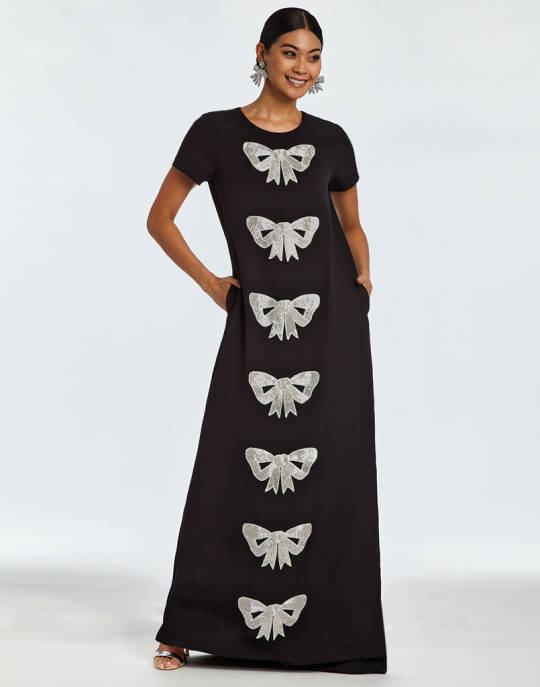#mestiza gown
Explore tagged Tumblr posts
Text

This classic mestiza gown is a timeless choice for your next event. The boat neck is accentuated with an alluring beaded design and it features butterfly sleeves. With a comfortable long A-line skirt, this gown is both flattering and utterly sophisticated.
#barongtagalog#philippines#barongs#philippine culture#custommadebarongtagalog#filipinopride#madeinthephilippines#filipinoculture#filipinowedding#pinoy#mestiza gown#womensfashion#philippinewomen
3 notes
·
View notes
Text

When we think about barongs and #filipinianas, we often think about formal events like #weddings, glamorous parties, christenings, Buwan ng Wika, and other special Filipino occasions. But have you ever thought about the traditional Filipino outfit together with modern and casual everyday wear?
#barong tagalog#philippines#barong#pinoy#philippines fashion#barongtagalog#barongtagalogforwomen#womensfashion#shopping#barongs#wedding pillows#Mestiza Gown#alampy#philippine culture#pinny
1 note
·
View note
Text
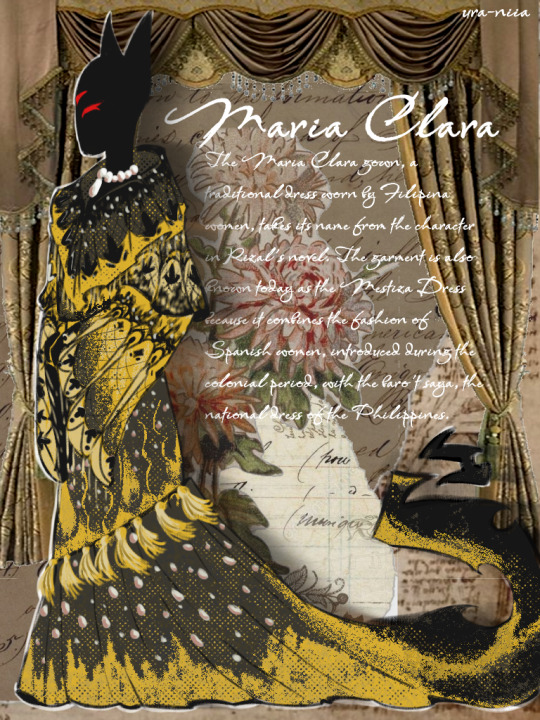
Narinder in a Maria Clara
History explanation:
— The Maria Clara gown, a traditional dress worn by Filipina women, takes its name from the character in Rizal’s novel. The garment is also known today as the Mestiza Dress because it combines the fashion of Spanish women, introduced during the colonial period, with the baro’t saya, the national dress of the Philippines. Maria Clara herself was also a mestiza character.
Maria Clara is one of the major characters in Noli Me Tángere (Touch Me Not), one of the most celebrated novels by 19th century Filipino nationalist Jośe Rizal. In the novel, Maria Clara is the only daughter of Capitán Tiago, a rich Filipino landowner during the Spanish colonial occupation of the Philippines. Her beautiful appearance is emphasized several times throughout the novel, as is her kind and pleasant personality.
While the Philippines were occupied by Spain, the Maria Clara gown was worn by mestiza and upper class women as a symbol of status. But when the United States colonized the country, the dress began to be considered less as fashion and more as “traditional” clothing. Today, Filipina women often wear the Maria Clara gown for official events or as a wedding dress.
Although the Maria Clara gown originates from the historic colonization of the Philippines by Spain, it has evolved into one of the most beloved traditional pieces of apparel among Filipina women. It can be said that this tradition grew out of the respect of the people of the Philippines toward Jośe Rizal and admiration for his famous character Maria Clara.
#this is really self indulgent#i just rly wanted to draw fem nari in my cultural clothing#and i got really carried away#my ass wanted this to be detailed#cotl#cult of the lamb#cotl fanart#cotl narinder#the one who waits#cult of the lamb narinder#narinder#cult of the lamb fanart#uraniia art#drew this on a phone#OH MY GOD I FORGOT HER BRAID
72 notes
·
View notes
Text
Wanted to share something I never seemed to have actually spoke about regarding my Mexico Oc; her hair!
I don’t believe I really ever explained the nuances of her (Lupita’s) hair, it’s rather ironic that I didn’t as I think her hair is what makes her stand out (hopefully) but hair in Mexican culture especially for women is rather important as it ties to our identity. However, I want to provide a bit of context to why I chose to style her hair the way I did!
- Hair Texture
I think wavy / loose curly hair is a rather commonly picked trait for female Mexico Oc’s as I’ve seen others who chose to use this texture which is rather nice tbh! Though, I’d like to explain why I chose to take this approach.
I’ve spoken before a little regarding my Oc’s heritage being indigenous, Nahua / Mayan in specific meaning that she has no biological / genetic relation to Europe as she’s not mestiza. Why I chose to make her indigenous can be saved for another post. Returning to this point however, this means Lupita was born with straight hair. While a texture =/= ethnicity in most cases, in MesoAmerica and in many indigenous communities in modern Mexico, the main type of texture amongst the people is typically straight and thick.
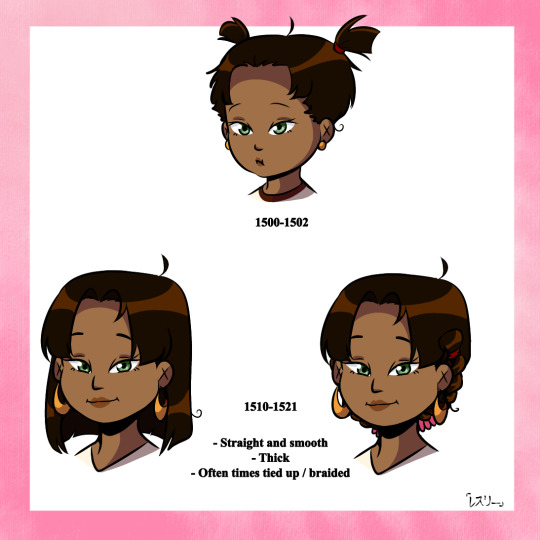
Indigenous hair styles tend to differ from region to region as many hair styles are commonly shared in different cultures. Braids, being arguably one of the oldest hair styles documented on the continent across practically all cultures, and then globally as well, have had a key significance in MesoAmerican and later Mexican cultures. Though girls and young unwed women were costumed to wear their hair loose in the Mexica culture, doing her hair in different styles is to me a form of storytelling and cultural referencing.
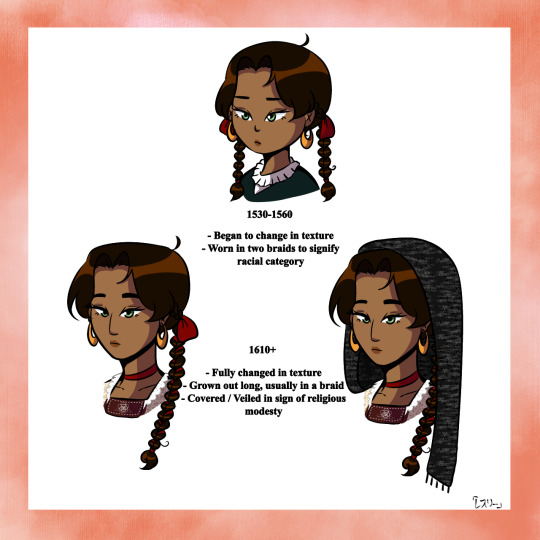
As I mentioned before; hair is often tied to identity. By the time the Spanish had colonized the area known as MesoAmerica and moved up into northern Mexico and the Southwest United States, the implementation of the Caste System had become a staple part of the new society. Lupita being an indigenous girl did not wear European gowns! Instead, she wore huipils (the traditional blouses / dresses of indigenous women) in order to identify her racial category but these huipils later on could also be made with European textiles, and sometimes even imitated European patterns. As a young teen, these fancy huipils were paired with a shawl she wore as a veil. Veiling was a common practice of modesty that was often tied to religious significance. Shawl veiling is still seen in Mexico now, mostly among older women when attending mass. Her veil often covered her hair that by this time had fully taken on its current wavy texture.
So what does all this mean in relation to Lupe’s hair? As I mentioned previously, though hair texture =/= ethnicity, it’s important that I also talk about the intense cultural shift that occurred in the continent as Mexico’s current culture itself is a “blend” of our original indigenous cultures and all the foreign influences. Whether those be European, African and even Asian! I figured that what better way to explore this influence than through hair. Hair is often times linked to culture and beauty in specific to women for the most part, women in Mexico put a lot of emphasis onto our hair because of how literally tied it is to our cultural identity!
- Hair Style
I want to dedicate this section to speaking on her hair style. I think I take a rather nuanced approach to this since I incorporate not just cultural aspects to her hair but also geographical. By now it’s kind of a running theme in the series for characters to sport accessories or have specific characteristics that represent certain cultural or geographical attributes of their lands so I thought I’d do so with mine.
Before I get into the details on why I chose to incorporate certain details into my Oc’s hair, I want to first talk a little about the hair in its natural state;
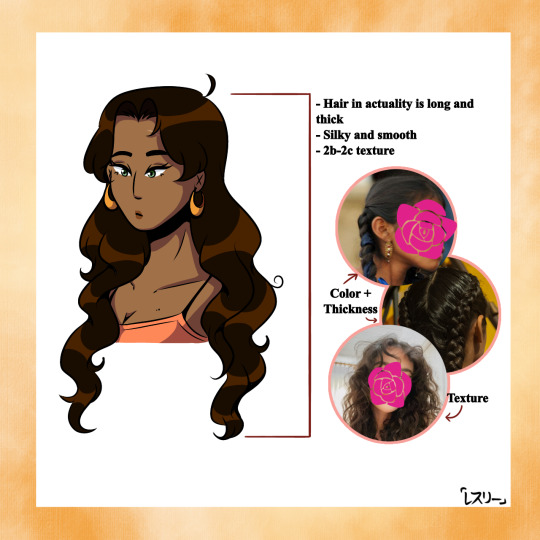
If anybody remembers when I used to draw her with her hair loose, you deserve a discount for sticking around for so long 🫡. Lupe sports long, thick, loosely waved hair that stretches well down her back. It’s dark in color, looking next to black, but its brown undertones show up best in sunlight. Her hair itself isn’t much on the surface level, it’s rather simple actually but I also think that it still holds some type of meaning. For centuries, long healthy hair was considered one of the most desired traits for women across many cultures and in Mexico it’s been no different. Women keep their gorgeous hair long and strong by braiding.
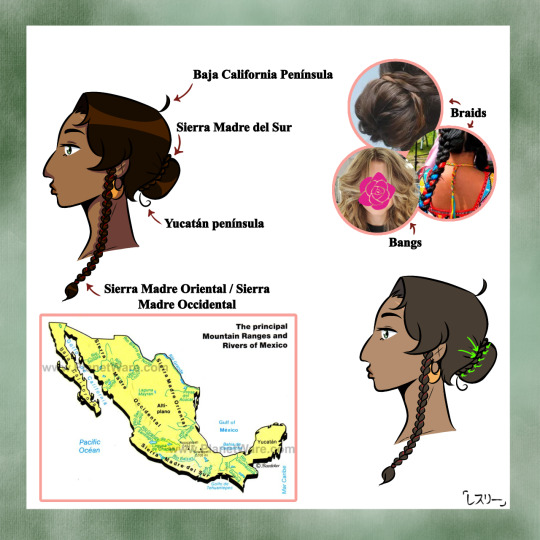
This brings me to my next point, her hair style! I think I unintentionally took a really creative approach when I was first drafting her design almost 10 years ago omg 😭 because I liked the way things looked. Her two little front braids are unintentionally similar to Nahua women’s “horned” style that signifies maturity and marital status but can also signify social status. Though a “mature” woman, Lupe is unwed. Her braids represent the two biggest mountain ranges of the country, those being the Sierra Madre Oriental and Sierra Madre Occidental, with a small red ribbon tied through them (shout out to my friend who gave me the idea). Ribbon tied braids are commonly seen amongst many indigenous communities but are also worn during holidays such as Independence Day (September 15-16th) and November 20th. Her bun is more of a “practical” choice. Though I enjoy drawing Lupita in different hairstyles, I know personally how hard it is to manage thick, textured hair, sometimes it’s just easier to put it up in a bun or something that keeps it neat and out of the way. The little braid that wraps around the base of her bun is a more recent addition, this represents the Sierra Madre Sur. The little curl and ahoge are self explanatory.
I think by now I get my point across but ofc I would appreciate any feedback on this since I don’t really do lore talks (if this even counts as one). I’ll gladly elaborate on any point !! Hope this was at least the tiniest bit of interesting for some of you 😅!!
#long post#aph#hetalia#hws#ヘタリア#aph mexico#hws mexico#aph oc#hetalia oc#talking about hair ig#it’s really just me yapping
11 notes
·
View notes
Text
19th Century Philippines Clothing (Upper Class)
Featuring William Shakespeare (Ikemen Vampire) and Auburn (@azulashengrottospiano)
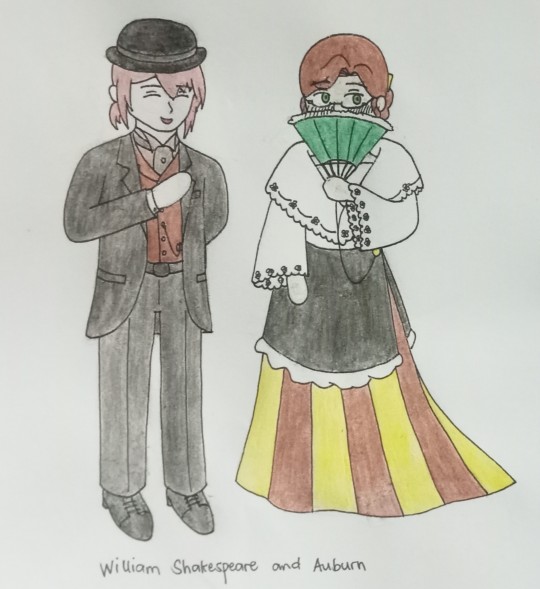
Full photo:
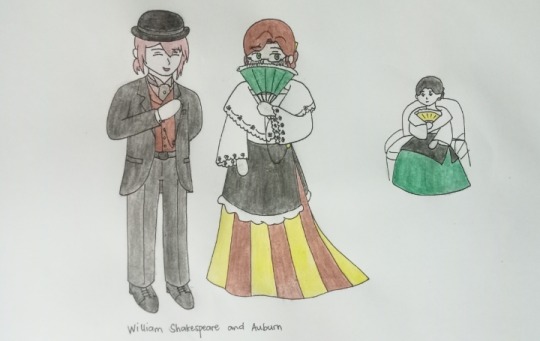
Just a guy from overseas visiting his ladylove 🤭
Fun facts:
– The traje de mestiza (translation: mestiza's gown), popularly known as the Maria Clara gown, is a type of traditional clothing in the Philippines worn by the upper-class Filipino women during the Spanish colonial era. It got it's name from Maria Clara, the heroine of the novels Noli Me Tangere and El Filibusterismo by Dr. Jose Rizal.
The camisa (blouse) and pañuelo or alampay (neckerchief) are made of piña, a type of fabric made from pineapple leaves' fibres. The saya (skirt) and the tapis (overskirt) are made of more opaque material like cotton or silk. Brocade and Jacquard fabrics are also used to make saya skirts worn by the upper-class women.
– Women at the time accessorize themselves by wearing peineta or payneta (decorative hair comb), necklaces, earrings, and abanikos (hand fans).
– Men who studied overseas (also called as Ilustrados, meaning "enlightened ones") are usually shown in photographs wearing late Victorian-style clothing. Upper-class Filipino men who lives in the Philippines during the 19th century wear barong tagalog which is also made of piña cloth. Canes are also a symbol of wealth amongst the upper class.
– Unmarried women are not allowed to meet a man alone without an older female relative watching over them. This is to ensure that the pair will not do something that is against the customs of the time (will elaborate on the next bullet).
– Unmarried couples are not allowed to hold each other, let alone kiss each other (kinda forgot but I think it has something to do with keeping a lady's purity until marriage or something).
If a man accidentally kissed an unmarried woman, he must take responsibility for it and marry her.
That's pretty much it! I had fun drawing these two— er, three, if the lady in the background is counted.
#can you even consider this an au? maybe??#cookie's art/doodles#ikemen vampire#ikevamp#ikemen vampire fanart#ikevamp fanart#ikevamp shakespeare#ikemen vampire shakespeare#19th century Philippine clothing
14 notes
·
View notes
Link

8 notes
·
View notes
Photo

me in the philippines during the 18th century (as a principalía): “bigyan mo ako ng bibingka at ang iyong ulo!!” (bring me bibingka and your head lol)
filipiniana dress-up picrew @ https://picrew.me/image_maker/326083
2 notes
·
View notes
Text
Filipiniana inspired by the Entities (the Eye, the Vast, the Dark)
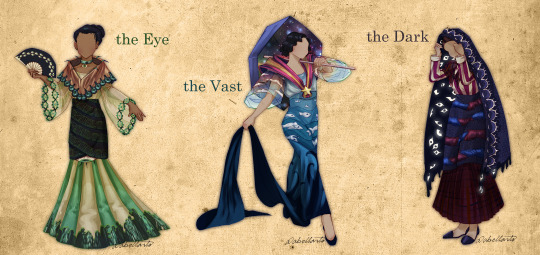

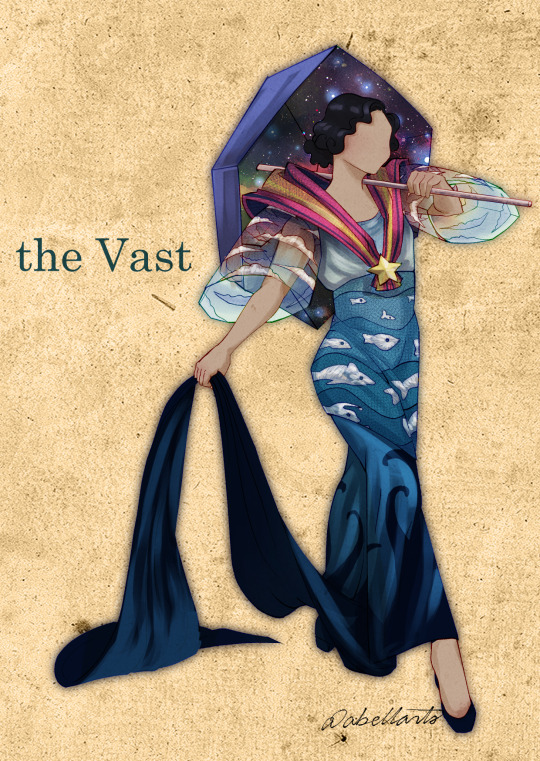

[ID: Three drawings of three modelled Filipinianas against a shared background which looks like aged paper. Each one is labelled a different entity which goes, from left to right, the Eye, the Vast, and the Dark. All the models are faceless. Three close ups follow the main image.
The Eye Filipiniana is an 1890s traje de mestiza featuring a brown panuelo with green embroidered trimming resembling ink pen tips and green strips resembling eyelashes at the opening, a translucent wide-sleeved striped baro in alternating off-white and green with green embroidered eyes for trimming, a dark cyan tapis with rows of books patterned on, and a silky striped saya in alternating yellow and green with an eye where the saya and the tapis meet and embroidery of people walking at the hem. Finished with accessories of a silky green necklace with a hanging realistic eye and a dark blue folding fan with an eye pattern. The model has brown skin and straight black hair up in a bun.
The Vast Filipiniana is a Commonwealth Era Style Baro’t Saya featuring a violet umbrella with a bright galaxy on the inside that the model holds on her shoulder, a magenta panuelo with yellow and orange stripes held together with a bright yellow star-shaped medallion, wide translucent butterfly-sleeved baro with a sunset to sky blue gradient from top to bottom with embroidered white clouds on the sleeves, a tapis with different shades of blue going from a light blue to dark blue top to bottom with embroidered silver fish of differing sizes, and a silky dark-blue-to-deep-blue saya with a long saya de cola with dark silhouettes resembling tentacles creeping up the sides. The model has pale tan skin and wavy hair held up in a loose lower bun.
The Dark Filipiniana is an 1840s Baro’t Saya styled for church-wear featuring a translucent plaid-patterned magenta panuelo, a striped straight-sleeved camisa in alternating dark magenta and off-white, a dark purple tapis embroidered with hands in alternating red and blue gripping each other by the wrist, a plaid-patterned magenta saya, and dark purple sandals. The models holds a dark purple hood over her head, the outside is a dark purple trimmed with white embroidery meant to look like closed eyes, the inside is a dark mass filled with open white eyes in strange positions, the dark mass drips down the edges of the hood, some eyes following. The model has ashy tan skin and combed back brown hair.
./.End ID]
Finally finished it! I’ve wanted to do this for a while but pushed it off until now. The Entities as a couple versions of the Filipiniana. I don’t have plans rn to make the others since I suspect I will soon be busy again. Still, I have some ideas, particularly for the Web. Have a favourite?
My inspiration+info under the cut! :D
1) The Eye
I based the Eye’s Filipiniana off of the “traje de mestiza”, an aristocratic ensemble popular during the 1890s near the end of Spanish colonial rule. It’s also known as the “Maria Clara” gown due to association with the main heroine of Jose Rizal’s novel “Noli me Tangere.”
Ngl I struggled to add more motifs than just “Eye” but I tried to be creative with it. The panuelo (the cloth around the shoulders) is supposed to look like eyelids which is why there are eyelashes. The embroidered trim is supposed to be the tips of ink pens. The trim of her sleeves are eyes. The tapis (the dark cloth around the lower area) features shelves of books. The bottom of the dress is supposed to be the Eye Watching people suffering at the hem. I got extremely lazy though and just got a “people walking” brush from the csp asset store and stamped them on. Didn’t get me the effect I intended but I was too tired to change it.

[ID: A sepia photograph of a woman looking to the left while wearing a traje de mestiza and holding a closed fan. /.End ID]
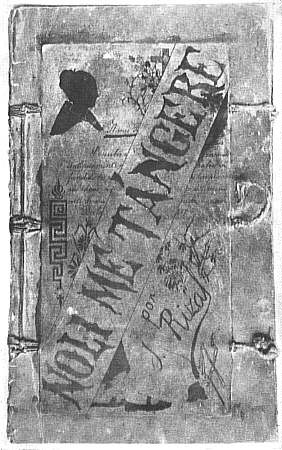
[ID: An image of the original front cover of Jose Rizal’s Noli Me Tangere manuscript./.End ID]
2) The Vast
The Vast’s Filipiniana I based off of the style popular during the 1930s-1940s Commonwealth Era. Honestly I only chose it because those sleeves are the very definition of vast.
The design has a simple concept but I ended up liking the end result a lot! It’s supposed to be a top to bottom gradient of aspects of the vast. Starting from space, going into sky blue, then ending in the deep abyss of the ocean.
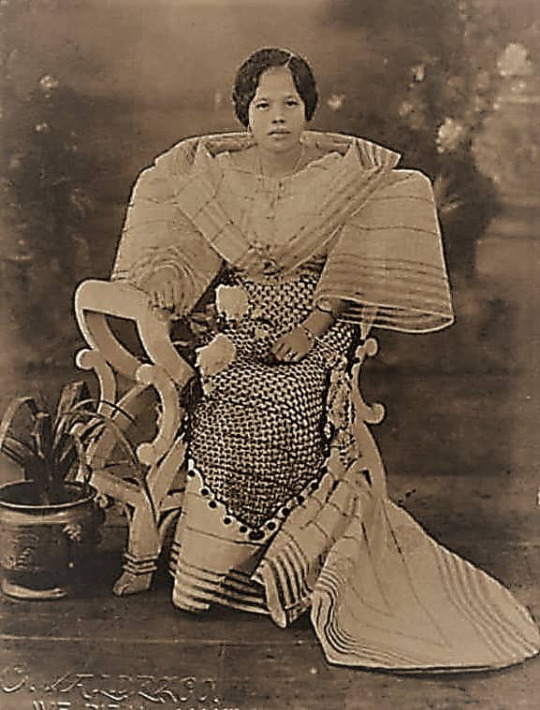
[ID: A sepia photograph of a seated woman wearing a Commonwealth Era Filipiniana. /.End ID]

[ID: A black-and-white photograph of three young women wearing Baro’t Saya in the Commonwealth Era style in a forest setting. All three have their panuelo wrapped around their heads. The girl farthest in the back carries an open umbrella./.End ID]
3) The Dark
Lastly, the Dark’s Filipiniana is based off of 1840s church-wear. I thought I could do something with the hood and the church theme suited the Dark well.
I’ll admit the Dark gave me trouble. Dark is a very vague theme. The hood is the main focus of the dress I think as everything else is pretty standard/I ripped off from the original whoops. The trim is supposed to look like a bunch of closed eyes. The inner hood is a dripping black mass with eyes from who-knows-where. The tapis has a pattern of several hands grasping each other by the wrist because something unknown gripping you from the dark is terrifying. “The blanket never did anything” anyone?
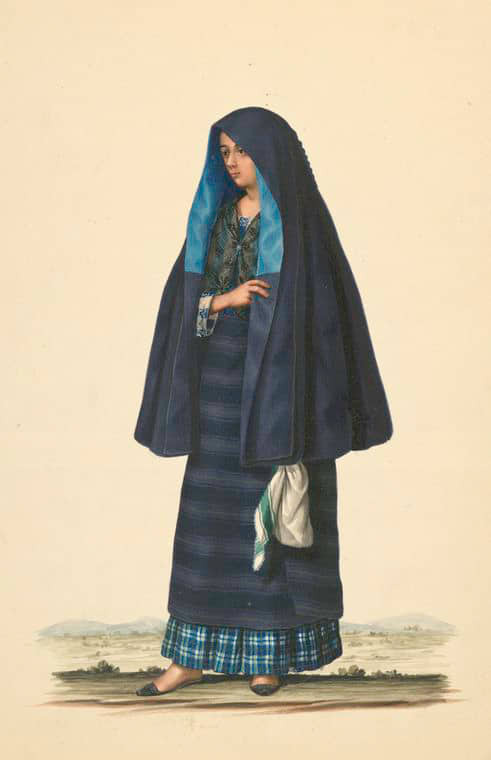
[ID: "A damsel going to early mass," by Justiniano Asuncion, 1841. The painting features a woman looking to the left, wearing darkly coloured 1840s church-wear with a hood, she holds a white cloth in her right hand./.End ID]
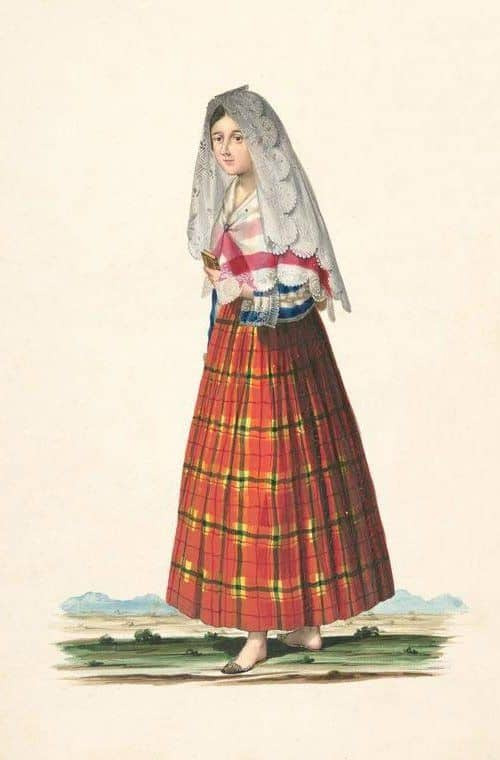
[ID: "A señorita walking to church in the daytime," by Justiniano Asuncion, 1841. The painting features a woman looking to the left, wearing brightly coloured 1840s church-wear with a thin gauzy white hood. She holds a small book, presumably a bible. ./.End ID]
#tma#The Magnus Archives#MagnusPod#MagPod#The Entities#The Eye#The Beholding#The Vast#The Dark#Abellarts#i worked hard on this don't flop/j
652 notes
·
View notes
Photo

MESTIZA GOWN #5009.
Turn heads in Mestiza dress embellished with brilliant beads that adds shimmer and curve-skimming gown that glide its way to a flouncy mermaid.
https://www.barongsrus.com/mestiza-gown-5009-p-7821.html
0 notes
Text
Introducing our exquisite Ladies Barong Tagalog, a timeless and elegant piece that embodies the rich cultural heritage of the Philippines. Handcrafted with meticulous attention to detail, this Filipiniana Beige Formal Embroidered Beige National Costume is a masterpiece of craftsmanship and style.

Handmade Elegance: Each Ladies Barong Tagalog is lovingly handmade by skilled artisans, ensuring the highest quality and attention to detail.
Color and Collar: The soft, soothing Beige/Ecru hue of this Barong Tagalog exudes sophistication and grace. The Chinese collar adds a touch of traditional charm while maintaining a modern appeal, making it suitable for various formal occasions.
Embroidered Beauty: The delicate embroidered floral design gracing the front of the Barong Tagalog is a testament to the rich Filipino heritage. These intricate patterns add a touch of femininity and elegance, making this garment perfect for special events and celebrations.
Neckline and Closure: The split neckline adds a hint of allure while maintaining modesty, allowing you to showcase your style. The full-open button front adds convenience and allows you to customize your look to suit the occasion.
Sleeves and Fit: The 3/4 sleeves perfectly balance traditional and contemporary, offering comfort and versatility. The semi-fitted shape flatters your silhouette, ensuring you look your best on any formal occasion.
The traditional dress for women in the Philippines reflects the rich cultural history and diverse influences that have shaped the country over centuries. Here are the key traditional garments:
1. Baro’t Saya
Baro’t Saya is one of the most iconic traditional outfits, consisting of a baro (blouse) and saya (skirt). This ensemble dates back to the pre-colonial era but evolved during the Spanish period, blending native and European elements.
The baro is typically a long-sleeved, sheer blouse made from lightweight fabrics like piña or jusi, while the saya is a long, flowing skirt. Women often pair this with a pañuelo (scarf or shawl) and a tapis (decorative overskirt or apron).
This style is often worn during cultural events or festivals.
2. Maria Clara
The Maria Clara dress is a more formal and elaborate version of the Baro���t Saya. It consists of four key components: the baro (blouse), pañuelo (a large shawl or scarf), saya (skirt), and a tapis (an overskirt or apron worn around the waist).
This dress is named after the iconic character Maria Clara from José Rizal’s novel Noli Me Tangere. It symbolizes the modesty, grace, and femininity of Filipino women, with Spanish influences apparent in its design.
The materials used are often luxurious, such as piña and jusi, with intricate embroidery or lacework.
3. Terno
The Terno is another well-known traditional dress, recognized for its butterfly sleeves—large, stiff sleeves that stand out from the shoulders. The modern Terno evolved from the Maria Clara, but today it’s often a one-piece formal gown worn for prestigious occasions like state functions and formal galas.
The Terno became a national symbol, particularly during the American colonial period and in the mid-20th century, when First Lady Imelda Marcos popularized it.
This dress is often made from fine fabrics and is highly embellished with embroidery, beadwork, or lace.
4. Traje de Mestiza
The Traje de Mestiza is a more ornate version of the Terno, featuring elaborate embroidery, a fitted bodice, and often a train. It was a favorite during the Spanish colonial period, particularly among wealthy mestizo (mixed-race) women, hence the name.
It has butterfly sleeves and a more extravagant design compared to the Maria Clara and the simpler Baro’t Saya.
5. Patadyong
The Patadyong is a wraparound skirt commonly worn by women in rural areas, especially in the Visayas and Mindanao regions. It’s made of woven, colorful, checkered cloth and is paired with a simple kimona (blouse).
The Patadyong is practical and comfortable for daily use but is also worn during traditional ceremonies and dances.
6. Malong
The Malong is a traditional tubular cloth worn by both men and women in the southern Philippines, particularly among Muslim communities in Mindanao. Women wrap the malong around their bodies in various ways, either as a skirt, dress, or even a head covering.
It is often made from vibrant, woven textiles with geometric or floral patterns, reflecting the cultural heritage of the Maranao, Maguindanao, and Tausug people.
7. Kimona and Saya
The Kimona is a simple, semi-transparent blouse usually made from lightweight fabrics like jusi or cotton. It is worn with a long saya or skirt, often made from a thicker, colorful material like silk or cotton.
This outfit is popular in the Visayas region and is often worn for festive events or traditional dances.
Modern Adaptations
Today, these traditional garments are worn during significant cultural or national celebrations, such as Buwan ng Wika (Language Month), Independence Day, weddings, and other formal occasions. Modern designers have also adapted Filipiniana dresses, incorporating contemporary elements into these traditional styles for a more fashion-forward look while maintaining their cultural significance.
These dresses not only represent the beauty of Filipino craftsmanship but also serve as symbols of Filipino identity, pride, and history.
#barongtagalog#philippines#barongs#philippine culture#custommadebarongtagalog#filipinopride#madeinthephilippines#filipinoculture#filipinowedding#pinoy
1 note
·
View note
Text
A group of popular K-Pop stars wore Barong Tagalogs while participating in the South Korean variety show “Idol Truck” filmed in Clark, Pampanga.
In this show’s 13th episode, Sandara Park and her fellow K-Pop stars, DinDin, WINNER’s Jinu, and NU’EST’s JR and ARON visited a boutique and tried on Filipino clothing.

(Source: Photos are posted by @daraxxi on Instagram)
Igniting the Filipinos’ Pride through the Posts
Filipino fans reacted and shared on Sandara’s Instagram posts. The view of Philippine barong Tagalog clothes on international stars has resulted in many Pinoy fans expressing their reaction and admiration for international personalities.
Before becoming a K-Pop idol, Sandara was part of the reality show Star Circle Quests in 2004. The show was popular at the time, and was the factor that helped Sandara rise to popularity. After competing in the show, Sandara starred in various shows in ABS-CBN, such as Crazy for You, And Your Song: Everything you Do, to name a few.
Sandara took to Instagram to express her gratitude towards her Filipino fans. She posted “Sobrang nakakagulat at nakaka-flatter na hanggang ngayon, kilalang-kilala pa ako ng mga Pinoy. Maraming salamat sa love and support niyo sa akin! Mahal ko kayo! Forever!”
She also followed it with “Sa halos lahat ng generation, naalala pa nila ako. Kahit sa mall, sa market, sa restaurant, sa lahat ng places. Nakakagulat. I’m so happy!”
The Korean celebrity is touched for the continued support and acknowledging the enduring remembrance towards her fans.
The Impact of Barongs Among the Locals
The photo that Sandara shared greatly shows how elegant these celebrities are with the local barongs. It instills and triggers Filipinos’ deep pride in the country, where wearing traditional national clothing adorned by popular figures is a sight.
It gives the Filipinos the feeling that they are admired by looking at their best with our national costume. When well-known figures don these attires, it sends a message that showcases the Philippines’ rich heritage and its worth of global recognition.
Additionally, celebrities, such as Sandara, pique the interests of people on a worldwide scale, potentially boosting the country’s tourism and demand for Filipino products.
It is especially the case when Sandara visits the country and wears traditional clothes alongside her fellow K-idols, bringing light to the local establishments and clothing.
The Right Place to Find Barong Tagalogs
Barongs R Us offers many modern barong Tagalogs, perfectly suitable for any occasion and budget. Our barongs range from classical to modern, stylish take on local clothes.
If you are looking for a barong for celebrating a special occasion, staying true to your roots, or looking good at the perfect photoshoot, we have one that fits your preferences and helps you stand out from the crowd.

Visit our official website today to choose the perfect barong from our collections. Don’t settle with a leveled style, consider checking our options out and see why celebrities around the world are starting to follow this modern trend.
#barong tagalog#philippines#barong#pinoy#philippines fashion#barongtagalog#barongtagalogforwomen#womensfashion#shopping#barongs#mestiza gown#mestiza dress
1 note
·
View note
Text
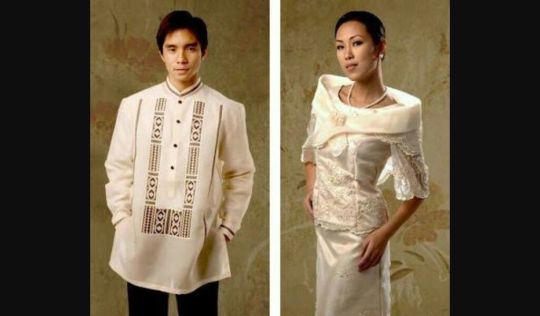
1.) FASHION IN THE PHILIPPINES
BARO'T SAYA AT BARONG TAGALOG
The baro’t saya or baro at saya (literally "blouse and skirt") is a traditional dress ensemble worn by women in the Philippines. It is a national dress of the Philippines and combines elements from both the precolonial native Filipino and colonial Spanish clothing styles.It traditionally consists of four parts: a blouse (baro or camisa), a long skirt (saya or falda), a kerchief worn over the shoulders (pañuelo, fichu, or alampay), and a short rectangular cloth worn over the skirt (the tapis or patadyong).
The baro't saya has multiple variants, including the aristocratic traje de mestiza (also called the Maria Clara or Filipiniana); the Visayan kimona with its short-sleeved or poncho-like embroidered blouse paired with a patadyong skirt; as well as the unified gown known as the terno, and its casual and cocktail dress version, the balintawak.[1] The masculine equivalent of baro't saya is the barong tagalog.
The barong tagalog (lit. "Tagalog dress"), more commonly known simply as barong (and occasionally baro), is an embroidered long-sleeved formal shirt for men and a national dress of the Philippines. Barong tagalog combines elements from both the precolonial native Filipino and colonial Spanish clothing styles. It is traditionally made with sheer textiles (nipis) woven from piña or abacá; although in modern times, materials like silk, ramie, or polyester are also used. It is used in special occasions in the Philippines.
It is a common formal or semi-formal attire in Filipino culture, and is worn untucked over an undershirt with belted trousers and dress shoes. Baro't saya is the feminine equivalent of barong tagalog, with the Maria Clara gown being the formal variant of the latter. Barong tagalog was also known as camisa fuera ("outer shirt") in Philippine Spanish.
9 notes
·
View notes
Photo

“Reference of Addy’s traditional Filipino gown”
This gown is actually the same gown I wore on my 18th birthday which is the theme traditional Filipino clothing because my birthday, June 12 is the date of the Independence Day of the Philippines (in which it became a pun since my my family laughs onto why my choice of theme is traditional clothing).
Let me explain the details since I deeply adored and loved this gown and you may saw several drawings from previous posts on my blog.
-------------------------------------------------------------------------------------------
The gown is called “Maria Clara gown” (you can find the description here), I wanted the gown to be black and white because of the vibe of the old century feel of the world of black and white (Note: It is supposed to be pink recommend by my many aunts but I choose Black and White).
Wearing a white strapless, off shoulder Baro/Camisa (blouse) with long sleeves that cover the palm, but the elbow to the end of the sleeves are made out of Piña or Sheer (Note:Since I am not a professional artist who can do see through drawing like sheers and glass like so I draw the way I drew). A black Pañuelo (a Handkerchief) around the shoulders with floral design (Note: the design of the handkerchief is not accurately the same as the real one so I customize my own floral design that fits the dress that I like or something simple).
Finishing off with accessories; a black choker necklace with a single white pearl, a silver brooch with a single big white pearl and diamonds that pin the Pañuelo together without falling, a silver chained bracelet with a blue heart with tiny diamonds, and a white pearl earrings and a silver ring with a white pearl alongside with tiny diamonds (I didn’t put those two accessories on the drawing, I forgot though).
Wearing a black Saya (a long skirt) and a simple Bakya (a wooden clogs/footwear) that has a gray knitted strap with White Angel flowers on top.
The other accessories on this drawing though is not include since I don’t wear those in real life but adds the accuracy of the real life historical Mestiza class woman. The white Veil that has a simple light gray venice lace with many White Angel flowers, petals and tiny pearls at the bottom of the veil. It attach with a big White Angel Flower hairpin on the right side of the hair (with or without veil). A black and white folding fan, the black guard has silver lining detail and the design of the leaves of the fan is a similar design as the veil (I didn’t draw the floral design on the fan since I am too lazy).
Reference like these photos:











(Warning: Below is me wearing my gown)


Its me!!! ^w^
65 notes
·
View notes
Text
LEMME JUST APPRECIATE MY CULTURE


“The Filipiniana gown is a formal outfit for women. It was only worn by mestizas during the Spanish colonial period as it combines the elements of both indigenous and Spanish designs. This formal outfit was popular during the Philippine-Spanish colonial era, especially in the 1890s.”


“Maria Clara is a character and heroine in the novel Noli Me Tangere written by Philippine national hero, Dr. Jose Rizal. Maria Clara is symbolized as the virtue and nobility that makes up a Filipina woman. The Maria Clara originated from the baro’t saya of the early Filipinos. It consisted of a loose long-sleeved blouse placed over a wide, ankle-length skirt. The Maria Clara has four pieces to complete the ensemble. It includes the baro/camisa, the saya, the panuelo, and the tapis.”
Here is an article going in-depth about the history and origins of The Maria Clara Dress
#the maria clara#history about philipine clothing#the inticacy involved in these amazing gowns#they are so beautiful#the philippines
5 notes
·
View notes
Text
Capitol Theater
Pre-war Manila was a city of entertainment, its streets lined with nightclubs, cabarets, theaters, cinemas, and social clubs. The city had so much theaters that some were built right in front or beside each other. So, along the stretch of the beautiful Escolta is a first-class theater that many members of the alta sociedad prefer, which is the Capitol Theater.
The Capitol Theater sits on prime land at the western side of the Escolta, once the country's premier business and shopping area north of the Pasig River. The Capitol Theater is one of the city's many cinema theaters, but not the Escolta's only cinema as its rival (later sister) theater Lyric is only two buildings away from the Capitol.

Photograph by Joel Vivero Rico
The Capitol Theater was built in 1935, and a masterpiece of National Artist Juan F. Nakpil de Jesús, who also designed the Pérez Samanillo Building together with the great Andrés Luna de San Pedro. It was designed and built in the art-deco style of architecture, an architectural style that was prevalent in the 1920s and 1930s. The Capitol had a total of eight hundred seats, and one of Manila's air-conditioned theaters. One interesting feature of the Capitol was its design. Inside the theater, Nakpil made use of double balconies, which was then a rare architectural design. Its lobby adorned murals designed by the triumvirate composed of Filipino modernists Victorio C. Edades, Carlos V. Francisco, and Galo B. Ocampo. According to documents, Nakpil originally commissioned Edades to work on the mural. Edades then chose 'Botong' Francisco to be his assistant, who then brought with him Ocampo. The three had just returned from the United States and hoped to change the Philippine art scene long dominated by the masters Fernando Amorsolo and Guillermo Tolentino.

Ramos,B. The Ruins of the Capitol Theater Post-WWII occupied by thr Silver Slipper Club, a nightspot catering mostly to U.S. servicemen. Retrieved from https://news.abs-cbn.com/ancx/culture/spotlight/03/31/19/goodbye-to-capitol-escolta-is-losing-another-significant-heritage-building
There are other interesting things about the Capitol Theater. Its façade has two bas-relief sculptures designed by Italian sculptor and expatriate Francesco Riccardo Monti. Monti's other works also include the bas-relief sculpture called 'Furies' at the old Meralco (then Manila Electric Railroad and Light Company, now the Manila Electric Company) Building along Calle San Marcelino, sculptures atop University of Santo Tomás' main building, and the sculptures at the Quezón Memorial in Quezón City.
The Japanese occupation came about in 1942, with the defeat of the combined Filipino and American forces in Corregidor. During the war years, the Escolta still continued to be the center of gravity in the city. Since most theaters in the city featured American films before the war, they were banned from being showed by the Japanese High Command. The Capitol instead showed local films, live production acts, and Japanese propaganda tools. It has been said that Fernando Poe Sr. was a film producer in the Capitol during the Japanese occupation.
Recently, the Capitol's interior has been abandoned, leaving only its façade. Several small business establishments and a restaurant used to operate inside. As for the line of the building it is strong lines and soft curves outline the pleats of the gowns worn by the muses.For the texture, fascinated with the texture on the side of this Art-deco building demolition, it's like looking at the innards of a huge old fossil.The shapes on this building was made of organic shapes because the building was made of free formed and also a geometric shape because some structures are precise.The form of the building is 3D because it is an actual building and you can touch it. Color, the color of the building has faded that’s why the color that you can only see in the building was color white and some dark color.Value, the value of the building is now white and dark because of the structure of the building now.Space, positive space because the building was filled of different interiors. Composition, a building that is made of both of the vertical surfaces have low-relief figures depicting two Filipina muses which are portrayed wearing native dress or 'traje de mestizas' and local fauna which include carabao head. This was done by Francesco Riccardo Monti.
There are initiatives done to preserve the historic Escolta. The Escolta Commercial Association is an organization composed of owners of business establishments along the Escolta. Also, another intiative called 'Hola Escolta' was made in 2012 which seeks the revitalization of the Escolta.
Rubío, P., Rubío, P. and profile, V. (2019). Capitol Theater. [online] Arquitecturamanila.blogspot.com. Available at: http://arquitecturamanila.blogspot.com/2014/03/capitol-theater.html [Accessed 2 Dec. 2019].
Rom, Khyla | Sangilan, Steffanie B.
3 notes
·
View notes
